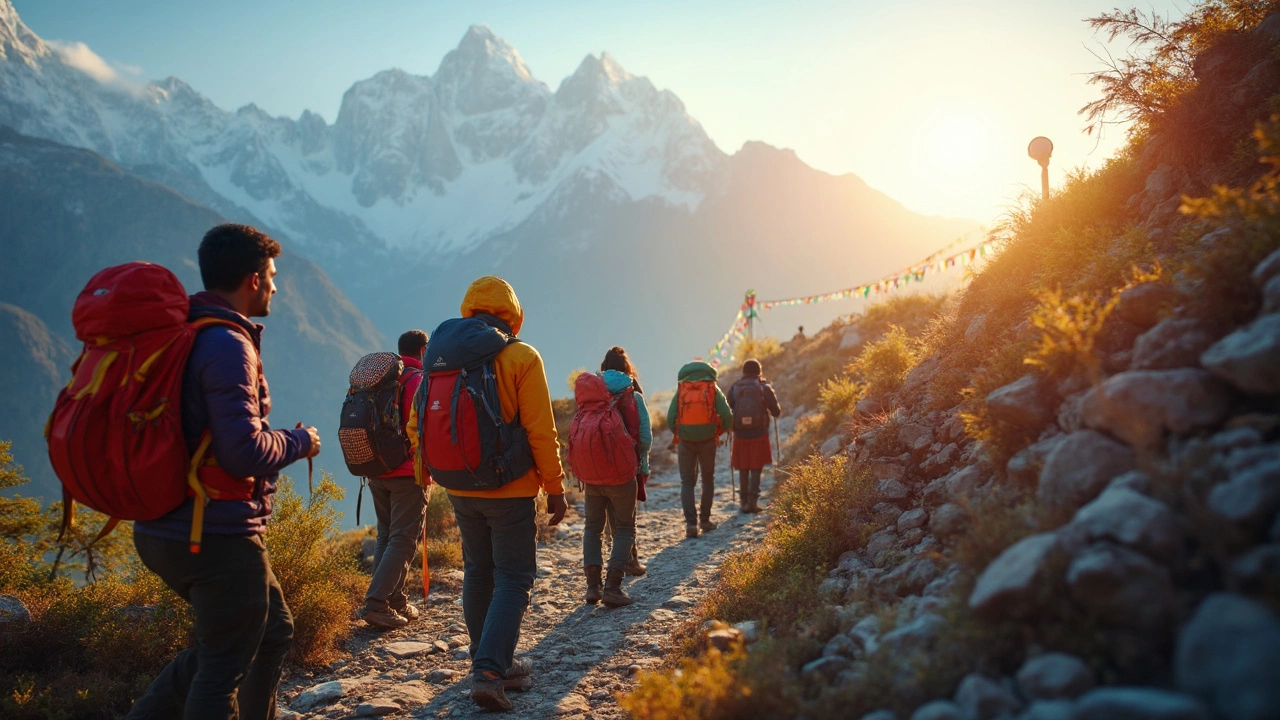Greatest Adventure Ever: Chasing Epic Stories and Real-Life Thrills

What actually makes something the greatest adventure ever? Is it climbing Everest, walking the length of the Amazon, or going somewhere nobody’s ever heard of? Believe it or not, there’s no single answer. For some, the real thrill is in the risk, going way past comfort zones and facing the unknown. For others, it’s more about breaking records or even just finding themselves somewhere totally new.
Here’s a fact that might surprise you: when Edmund Hillary and Tenzing Norgay first stood on Everest’s summit, they only spent about 15 minutes up there—in brutal cold, with failing equipment, and not even sure if they’d make it back down. The point is, legendary adventures don’t look like the Instagram posts. They’re gritty, weird, and messy as often as they are heroic.
But you don’t need to go halfway around the world to find your own adventure. Sometimes it’s about tackling a challenge you’ve avoided for years, or saying yes to something that scares the heck out of you. If you want a little more excitement, there are some practical steps you can actually start today—no need to wait for a magic sign or perfect timing.
- The Meaning of Adventure
- History’s Most Legendary Missions
- Wild Fiction: The Adventures We Dream About
- Tips for Living Your Own Epic Story
The Meaning of Adventure
Adventure isn’t just some wild trip or a race to a new record. It’s a mindset—a way of approaching life with guts, curiosity, and the urge to push past what’s regular. The greatest adventure ever means different things to different folks. For some, it’s crossing Antarctica on foot. For others, it might be their first road trip alone, getting lost and figuring things out as they go. What really counts is leaving your comfort zone and facing something uncertain.
There's a cool science bit too. A recent survey by the Adventure Travel Trade Association showed that 74% of travelers said facing a challenge like hiking, climbing, or exploring a new culture made them feel more alive and confident. Serious physical adventures are proven to spark big boosts in mood and self-esteem, and people tend to remember these experiences long after they forget the details of daily life.
If you look at history, adventure defined entire eras. The Age of Exploration—think Magellan, Earhart, and Shackleton—was about more than just finding new land. These pioneers risked their lives, and their adventures helped map the world as we know it. The map below shows some of the greatest journeys ever taken by real-life explorers:
| Explorer | Year | Adventure Highlight |
|---|---|---|
| Ferdinand Magellan | 1519-1522 | First circumnavigation of the globe |
| Roald Amundsen | 1911 | First to reach the South Pole |
| Ada Blackjack | 1921-1923 | Survived Arctic alone for 2 years |
| Valentina Tereshkova | 1963 | First woman in space |
So what’s the common thread? It’s not the location or the fame. It’s about challenging yourself, pushing limits, and coming back changed. Even modern science agrees: our brains crave that mix of risk, reward, and learning. If you want a shortcut to making life feel bigger and more memorable, seeking out adventure is one of the best bets you’ve got.
History’s Most Legendary Missions
When you ask people about the greatest adventure ever, some names come up over and over: Shackleton, Earhart, Armstrong. These weren’t movie heroes—they were regular people who somehow pushed way past the limits most of us think are possible.
Take Ernest Shackleton’s Antarctic trip in 1914. His ship, the Endurance, got trapped in ice, stranding his crew for almost two years. They never even reached their main goal, but get this—not one of the 28 men died. Arctic survival meant eating seals, living on ice floes, and dealing with freezing winds. Shackleton’s leadership is still taught in business schools because he brought everyone home alive against every odd.
Now, think about Amelia Earhart. She broke all sorts of records, including being the first woman to fly solo across the Atlantic. In 1937, she set out to circle the globe, but disappeared over the Pacific—her story is still one of the biggest mysteries in adventure history. What’s not a mystery is how she inspired generations to go after what everyone said was impossible.
Then there’s the space race—talk about greatest adventure. In 1969, Neil Armstrong did what seemed unthinkable by taking the first step on the moon. That moon walk lasted just a couple hours, but the Apollo 11 crew trained for years, facing wild risks: explosions, bad calculations, running out of fuel. It changed what people believed humans could do forever.
Some records in adventure are downright wild. Here’s a quick rundown:
| Adventure | Year | Key Fact |
|---|---|---|
| Climbing Mount Everest | 1953 | Hillary & Norgay: first summit, no bottled oxygen |
| Swim the English Channel | 1875 | Captain Matthew Webb: 21 hours, no wetsuit |
| Around the world solo sailing | 1969 | Robin Knox-Johnston: over 312 days at sea alone |
| Rowing the Atlantic | 1966 | Ridgway & Blyth: 92 days in a 20-foot boat |
Looking at these missions, one thing stands out: the biggest adventures always come with huge risks, but they end up changing the world, not just the people who go on them. If you’re chasing that next big story, studying these legends isn’t just for fun. You pick up smart strategies, get some real data on what works, and maybe even dodge mistakes that almost finished the pros.

Wild Fiction: The Adventures We Dream About
Adventure stories aren’t just for passing the time. They set the bar for what we call a real journey. Books like The Hobbit and Treasure Island gave millions of people their first taste of epic quests—pirate maps, dragon lairs, and all. Even if most of us won’t face trolls or sword fights in real life, these stories spark the same sense of excitement and fear as the real adventures do.
Ever wonder why so many top-grossing movies are about survival, lost worlds, or wild chases? Take Indiana Jones as a classic example. Not only did those films rake in billions, but they sent people scrambling to sign up for archaeology classes and jungle treks. The effect is real: Google Trends showed a huge spike in searches for “archaeology courses” right after the release of Raiders of the Lost Ark in 1981. That’s fiction pushing people to try real-life adventures.
Let’s put some numbers on it. Here’s how some classic adventure books and movies measure up in terms of popularity and impact:
| Title | Type | First Release | Worldwide Sales/Box Office |
|---|---|---|---|
| The Hobbit | Book | 1937 | Over 100 million copies |
| Treasure Island | Book | 1883 | Estimated 100+ million copies |
| Indiana Jones (franchise) | Movies | 1981–2023 | Over $2 billion (box office) |
| Jurassic Park | Movie | 1993 | $1.04 billion (box office) |
Wild adventures in fiction help us test out risk and reward in our heads before we ever get our shoes dirty. There’s research showing that reading adventure stories actually prepares people to deal with real-life problem-solving. If you’ve ever read Hatchet by Gary Paulsen, you probably picked up a few survival tricks without even noticing.
Here are a few tips for making the most out of these stories, whether you’re reading or watching:
- Look for honest moments of fear, doubt, and improvising—those are the real lessons, not just the action scenes.
- Ask yourself what you’d do differently than the main character. It sounds cheesy, but it’s surprisingly useful.
- Use these stories as launchpads for real-life challenges. Maybe you can’t outrun a boulder, but you can tackle something that scares you.
The greatest adventure can start in fiction, but it often leads people to try something real. Sometimes a wild story is the first push someone needs to break out of routine and go after their own epic story.
Tips for Living Your Own Epic Story
Starting your own adventure isn't just about hopping on a plane and hoping for the best. The biggest boosts to survival and enjoyment come from a bit of planning, some street smarts, and a willingness to improvise. Here are some practical tips—stuff that real explorers and seasoned travelers actually use out in the wild or in unknown cities.
- Greatest adventure secret: Preparation. It sounds boring, but you only realize what you need when you don't have it. Even Bear Grylls, famous for survival, has a kit packed with three knives, a water filter, and emergency chocolate.
- Know your limits, but expect them to change. Studies from the Journal of Adventure Education show that people consistently underestimate what they can do on day one, and overestimate how tough things will get. Most folks surprise even themselves—especially after they push through the worst day.
- Learn basic first aid and navigation. You don’t need to be a paramedic, but if you can handle a minor injury or use a map, you’re already ahead of half of casual adventurers. In 2023, Search and Rescue teams reported that 61% of callouts were for people who got lost or slightly injured in basic terrain.
- Start small if you need to. Epic doesn’t have a size limit. For example, Alex Honnold, famous for solo climbing El Capitan, started with indoor rock gyms and local boulders. You can build up from there.
- Document your adventure, not for the likes, but for learning. Keeping a journal or making quick voice notes helps you spot what worked—and what went way off-track.
Here’s a look at how preparation (the unglamorous stuff) leads to safe and successful trips:
| Preparation Type | Percent of Adventurers Who Prepare | Reported Success Rate (%) |
|---|---|---|
| Planned Route & Gear | 85% | 92% |
| Minimal Preparation | 10% | 56% |
| No Preparation | 5% | 21% |
One more important thing: share your plans. Let a friend or family member know where you’re going—doesn’t matter if it’s a national park, a mountain, or just outside your comfort zone. Even seasoned explorers leave a route note or a text before heading out. This tiny habit can save your life if things go sideways.
Getting started today? Pick one challenge. Sign up for that hike, join an unfamiliar group trip, or just take a different route to work. The stories you’ll tell aren’t about playing it safe—they’re about stepping into the unknown, little by little, and realizing you can handle way more than you thought.
